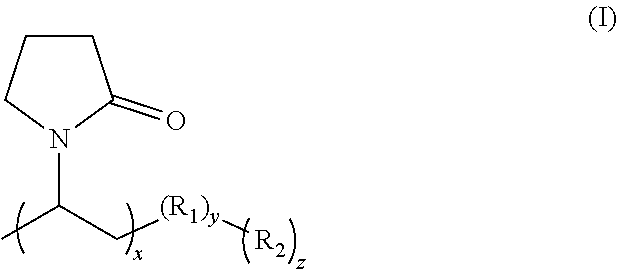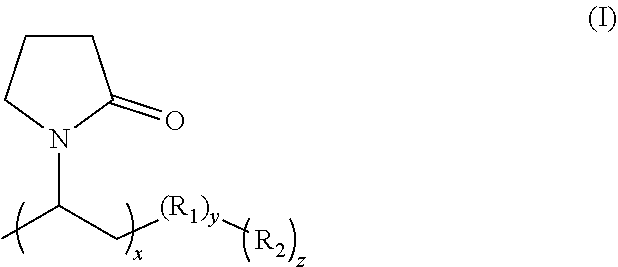Oral Care Compositions
a technology of oral care and compositions, applied in the field of oral care compositions, can solve the problems of remineralization at the surface of enamel, difficult formulation of mouth rinses, and almost half of the population still suffering from caries, and achieve the effect of inhibiting the demineralization of teeth
- Summary
- Abstract
- Description
- Claims
- Application Information
AI Technical Summary
Benefits of technology
Problems solved by technology
Method used
Image
Examples
example 1
[0084]An anionic copolymer of vinyl pyrrolidone (anionic PVP-copolymer) was prepared via copolymerization of n-vinyl pyrrolidone (VP) monomer with n-vinyl phosphonic acid (VPA) monomer via radical polymerization. The resultant copolymer is referred to as (PVP-PVPA).
[0085]Briefly, isopropyl alcohol (IPA, 125 g) was heated to approximately 80° C. in a round bottom flask under nitrogen atmosphere and gentle agitation. A monomer / initiator solution consisting of IPA (125 g), VPA (75 g), VP (175 g) and VAZO 52 (1 g, Chemours Inc.) was added gradually over 120 minutes. The reaction temperature was allowed to rise during the polymerization to 83-84° C. and maintained at this temperature for an additional 30 minutes before cooling to 77° C. An initiator chase solution consisting of VAZO 52 (0.4 g) in IPA (5 g) was added and the reaction mass was maintained at 77° C. for an additional hour. The polymer solution was then cooled, precipitated from hexane, and dried overnight under vacuum. The p...
example 2
[0086]The anti-erosion efficacy of PVP-PVPA synthesized in Example 1 was compared to commercially available PVP homopolymers (Sigma Aldrich—Cat. # PVP10, PVP4, PVP360) by measuring the pH change due to the dissolution of hydroxyapatite (HAP) powder in citric acid solution. Treatment solutions were prepared by dissolving the PVP homopolymers or PVP-PVPA copolymer in water and adjusting the pH using hydrochloric acid or sodium hydroxide.
[0087]In brief, prior to treatment, 100 mg of Ceramic Hydroxyapatite, Type I, 20 μm (Bio-Rad Laboratories, Inc.—Cat. #158-2000) was incubated for 2 hours at 37° C. in (Northeast Laboratory, Waterville, Me. —Cat. # T0300) to allow formation of salivary pellicle. Pellicle-coated HAP powder was subjected to one ten-minute treatment mixing end over end with 10 mL of assigned treatment solution. Treated particles were subsequently filtered using a 5 μm pore size, 25 mm diameter, polycarbonate membrane filter (Whatman® Nuclepore™ Track-Etched Membranes—Cat. ...
example 3
[0091]A second anionic copolymer of vinyl pyrrolidone (anionic PVP-copolymer) was prepared via copolymerization of VP with methacryloxyethyl phosphate acid (MOEP) and hydroxyethyl acrylate via radical polymerization. The resultant copolymer is referred to as (PVP-MOEP).
[0092]Both a high and low phosphate PVP-MOEP were prepared, by varying the ratios of the added monomers. Briefly, isopropyl alcohol (371.5 g) was heated to approximately 80° C. in a round bottom flask under nitrogen atmosphere. A monomer / initiator solution consisting of IPA (200 g), MOEP, hydroxyethyl acrylate (HEA), VP and VAZO 52 (3 g, Chemours Inc.) was added gradually over 120 minutes. For the high phosphonic acid PVP-MOEP the quantities of the monomers were 120 g MOEP, 25 g HEA, and 55 g VP. For the low low phosphate PVP-MOEP the quantities of the monomers were 68.44 g MOEP, 13 g HEA, and 118.55 g VP. Following addition of the monomer / initiator solution the reaction temperature was allowed to rise during the poly...
PUM
| Property | Measurement | Unit |
|---|---|---|
| temperature | aaaaa | aaaaa |
| temperature | aaaaa | aaaaa |
| temperature | aaaaa | aaaaa |
Abstract
Description
Claims
Application Information
 Login to View More
Login to View More - R&D
- Intellectual Property
- Life Sciences
- Materials
- Tech Scout
- Unparalleled Data Quality
- Higher Quality Content
- 60% Fewer Hallucinations
Browse by: Latest US Patents, China's latest patents, Technical Efficacy Thesaurus, Application Domain, Technology Topic, Popular Technical Reports.
© 2025 PatSnap. All rights reserved.Legal|Privacy policy|Modern Slavery Act Transparency Statement|Sitemap|About US| Contact US: help@patsnap.com


